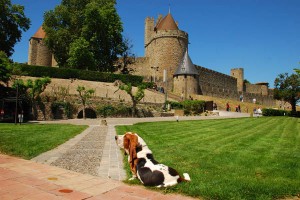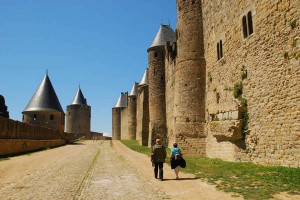
Staying at the Hotel du Chateau allows not just this fantastic view but also you get the company of the hotels' basset hound, Elliot
The fortified city itself is essentially of concentric design with two outer walls with towers and barbicans to prevent attack by siege engines. The castle itself possesses its own draw bridge and ditch leading to a central keep. The walls consist of towers built over quite a period. One section is Roman and is notably different from the medieval walls with the tell tale red brick layers and the shallow pitch terracotta tile roofs. One of these towers housed the Catholic Inquisition in the 13th Century and is still known as “The Inquisition Tower”.

It is difficult to believe that this magical city was nearly demolished due to its decrepit condition
In 1853, works began with the west and southwest walling, followed by the towers of the porte Narbonnaise and the principal entrance to the cité. The fortifications were consolidated here and there, but the chief attention was paid to restoring the roofing of the towers and the ramparts, where Viollet-le-Duc ordered the destruction of structures that had encroached against the walls, some of them of considerable age. Viollet-le-Duc left copious notes and drawings at his death in 1879, when his pupil Paul Boeswillwald, and later the architect Nodet continued the rehabilitation of Carcassonne.
The restoration was strongly criticized during Viollet-le-Duc’s lifetime. Fresh from work in the north of France, he made the error of using slates and restoring the roofs as pointed cones, where local practice was traditionally of tile roofing and low slopes, in a snow-free environment. Yet, overall, Viollet-le-Duc’s achievement at Carcassonne is agreed to be a work of genius, though not of strictest authenticity.
Fortification consists of a double ring of ramparts and 53 towers.
(From Wikipedia, photographs by James Derheim)
